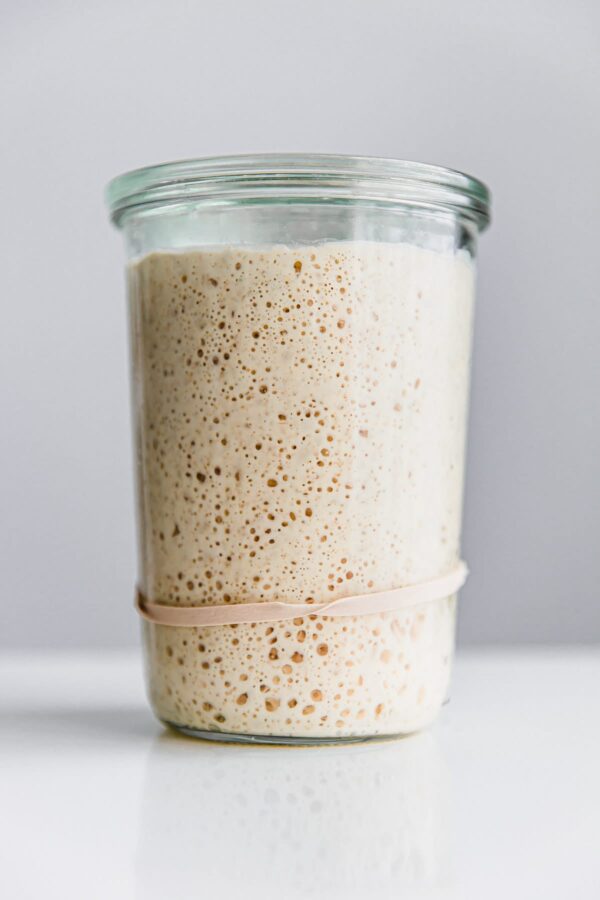
So in a typical rye sour dough wheat or spelt flour you use about 15 ratio of starter to flour. Because Rye has a stronger flavour in general and because you use much more starter to make a rye loaf than a wheat one heavier flour the taste is stronger.

Wholegrain flours have more complex carbohydrates that encourage more.
How to make my sourdough starter more sour. To make sourdough more sour choose organic white bread flour with 20 rye. Keep the starter warm and practice refreshing it after its reached peak height for about an hour just before it collapses. When making bread use a lot of starter in the recipe and let it rise for as long as possible.
Use More Wholegrain Flours In Your Sourdough Starter Using wholegrain flour in your sourdough starter will make your sourdough bread more sour. You can choose to use all wholegrain flour or a blend. Wholegrain flours have more complex carbohydrates that encourage more.
For milder sourdough use less whole wheat and less rye or consider sifting the bran out of whole wheat flour to create high-extraction flour. If using small amounts of whole grain save it for the main dough where it will have less time to contribute to acidity. 1 Use More Whole Grain Flour.
One easy way to make sourdough more sour and noticeably so is to incorporate more whole grains into your sourdough recipes. Flour made from whole grains such as whole wheat einkorn and rye naturally have more robust tangy flavors than white flour. Keep the starter at room temperature.
When I first made my starter it took about a week to be usable. To get nice sour bread you need to rise the bread for a long time. After I add the starter to the bread dough I rise it in a cool room for 7 or 8 hours which allows the bacteria time to produce plenty of lactic acid in the dough.
But the bacteria still have food to eat. They eat the expired yeasts along with the yeasts wastes and continue to produce lactic acid the main sour flavor. And so the starter gets more sour.
This video shows you how a sourdough starter works. My Sourdough Starter is Too Sour. All of the above principles apply here too.
Make sure to feed your starter when its hungry and use all purpose flour. Also make sure that you dont let your starter ferment too long before you use it. Use it soon after it reaches peak fermentation it doubles and passes the float test.
Add 1 cup 4 ounces whole-wheat or rye flour into a very clean 1-quart jar along with 12 cup 4 ounces warm tap or filtered water between 65 to 80 degrees F. Stir well until all the flour is. Because Rye has a stronger flavour in general and because you use much more starter to make a rye loaf than a wheat one heavier flour the taste is stronger.
So in a typical rye sour dough wheat or spelt flour you use about 15 ratio of starter to flour. In a typical 100 rye loaf you use 23. Much more starter to flour.
As a general rule the less sourdough starter you use the slower your dough will ferment - resulting in a more sour flavored loaf. The more starter you use the faster your dough will ferment -. To produce a more sour flavor grow your starter at warmer temperatures.
You can put your sourdough starter in your oven with the light turned on. This will bring up the temperature to around 30 degrees Celcius or 86 Fahrenheit. You will notice your sourdough starter growing much faster.
Try adding 12 teaspoon to 58 teaspoon sour salt citric acid to the dough along with the regular salt. To serve as pictured above split a loaf around the perimeter and layer one half with oil-packed sun-dried tomatoes or oven-roasted cherry tomatoes and fresh basil leaves. The best way to make sourdough starter is buying it off the internet.
The second best way is to post a request in Facebook that you are looking for starter. I guarantee someone will have some or know a guy who knows a guy who has some. And bread bakers are always willing to give some of their starter away.
Grab the kids for an impromptu science experiment when you test your sourdough starter in water. Place about a teaspoon of the starter into a cup of warm water. If it floats it should be ready for baking.
Even if your starter doesnt float it could still be ready. Go by the volume test to be sure. Flour for your starter Technically any grain-based flour works for making a sourdough starter.
Flours made from rice rye spelt einkorn and wheat all work. However bread flour works the best and yields the most reliable starter. Take 20 grams of your sluggish starter into a large bowl add 150 grams of water and give it a mix.
To this add 120 grams of white bread flour and 30 grams of rye flour. Stir really well to remove any lumps. Leave for around 8-10 hours and you should have a much more violent starter.
Carefully remove around 2 tablespoons of starter. Feed ¼ cup of water inside the container where you have stored the starter. Similarly also add anywhere between ¼ ½ cup of flour as well.
Place the starter somewhere at room temperature which should make it nice and bubbly. If you have to keep a.